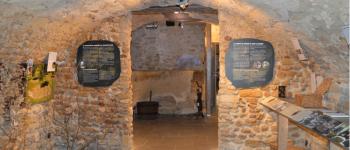
On the heights of Goult, near the Place du Castelet in the Lubéron region, stands a windmill similar to those in Provencal cribs. It can be reached on foot via a path leading from the village.
In 1750, it appears on the Cassini land register as "Tré Casteau" - outside the château - and was later renamed "quartier de Jérusalem", in memory of the crusades fought by the local lords of Agoult.
The mill
The mill is a two-storey masonry tower. The circular wall, 1.2 m thick, is topped with a crown of ashlar called a "cimas".
"Below, a vaulted base would have been used to load flour sacks. A staircase leads up to the millstone chamber, where the framework and operating mechanism are revealed.
The conical roof is made of planks assembled along the slope, offering less resistance to the mistral wind. At the top, a weathervane communicates with the interior of the mill, informing the miller of the wind's direction. The roof is movable on the rolling track, or "chemin de ronde", made of an assembly of arched wooden parts. This movement allows the wings to face the wind".
A little history...
Maïté Laurent's book "Goult chronique d'un village en Provence" tells us that, at the beginning of the 13th century, Raymond Beranger, Marquis and Count of Provence and Forcalquier, and Guilherma, Countess of Provence and Forcalquier, "in recognition of the services and loyalty of the men of Agoult, granted certain privileges to the inhabitants and their successors, in particular the right to build grain and oil mills".
In Goult, after the Agoult seigniory came the Sade and Donis seigniories. Throughout the seventeenth and eighteenth centuries, it was the Donis family. The last lord, the Marquis de Donis, lived in Goult until his death in 1805. The inventory of his possessions mentions an old mill and its outbuildings, without specifying whether he had exercised his right of banality. As the mill became "banal", all vassals in the fiefdom were obliged to grind for a fee.
In 1813, the mill was sold to Alexis Juillard by the heirs of the Marquis de Donis. In 1818, it belonged to André Bernard, miller in Goult, then to the Michel family in 1821. The last miller to have worked in Goult, Gabriel Michel, was in the 7th generation; his grandson, Jean Pierre Michel, was miller of a water mill in Fontaine de Vaucluse until 1968.
Listed in 1805, this mill "known as the Jerusalem mill" operated until the end of the 19th century. In 1947, the ruins of the building were acquired by the Institut Géographique National (IGN) for use as an astronomy teaching center.
The mill was sold to the commune of Goult, which undertook its restoration.
Jerusalem Mill
Rue du Jeu de Paume,
84220 Goult
Tel.: 04 90 72 20 16
http://luberon.fr/tourisme/les-sites-touristiques/monuments/annu+le-moulin-de-jerusalem+1701.html





